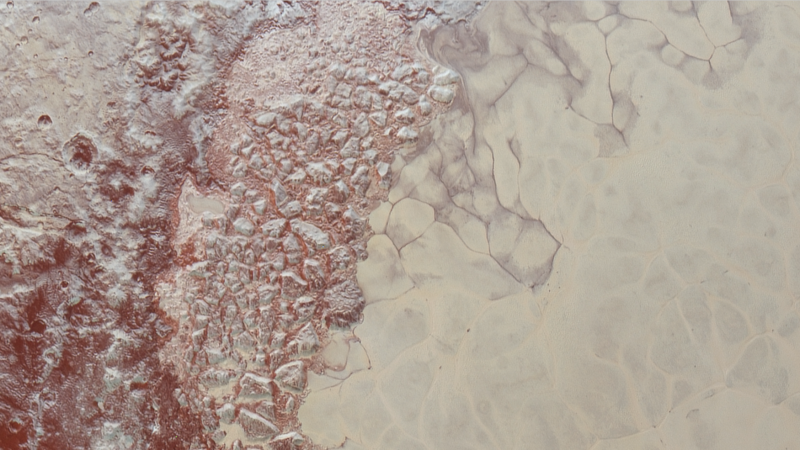
Astronomers peering closely at images of Pluto have spotted what look like dunes on the surface of the former planet. They wouldn’t be sand dunes, but dunes of methane ice—an Earthly feature on a totally alien world.
Dunes don’t just happen—they require both tiny grains and some sort of force, like wind, to push them into shape. When New Horizons passed by Pluto back in 2015, it captured dune-looking features just beside a mountain range. It’s a testament not only to jut how interesting distant cosmic objects can be, but how far humans have come in our ability to observe rocks in space.
“The best imagery prior to New Horizons was 12 pixels across for the whole dwarf planet,” study author Matt Telfer from Plymouth University in the United Kingdom told Gizmodo. “What we have now is evidence of a diverse, dynamic, and active geological surface. We see mountains, glaciers, and ice moving. Even despite the thin atmosphere, we see evidence of that atmosphere shaping the surface of that world just as it does on our own planet.”
Pluto’s dunes appear truly Earthly. They’re situated parallel to the edges of the adjacent mountains and perpendicular to the direction of nearby wind streaks. But they’re nothing like the wind-swept, sandy dunes of the Sahara. Pluto’s atmosphere is far too thin to pick up and push tiny grains of methane on its own.
Instead, the particles could be tossed into the air when nitrogen ice sublimes—turns from a solid into a gas, creating an upward jet of nitrogen gas. Once that happens, the planet’s feather-light breeze could push the methane particles, each about the size of a human fat cell, into the ridges observed by Telfer and the New Horizons team.
Discovering the dunes was possible through the combination of an analysis of the famous map of Pluto’s surface produced by New Horizons during its flyby, and the use of another scientist’s modeling. The researchers published their results today in Science.
The structures might not be dunes, of course. “We don’t see sediment move and we don’t see the dunes move,” Alex Hayes, a Cornell University astronomer who was not involved with the study, told Gizmodo. “But that’s the point. The whole paper sees this interesting feature and tries to interpret what they could be… The authors make a convincing argument, but without higher-resolution images, it’s hard to know for sure.”
It’s hard to imagine such a feature made any other way, though, said Telfer. And it wouldn’t be the first extra-terrestrial dune ever spotted, Hayes pointed out. Mars, Saturn’s moon Titan, and even the comet 67P/Churyumov-Gerasimenko each have seemingly Earthly wind-swept features.
As to what this might mean for the “is Pluto a planet” debate, the answer is nothing. Pluto is still classified as a dwarf planet, and whether or not we call it a planet is irrelevant to Telfer and his team’s work. After all, There are a host of other interesting and large worlds beyond Pluto. “One thing we’re all looking forward to seeing is New Horizon’s flyby of a Kuiper Belt Object on January 1, next year,” he said. Who knows what mysteries await us on that rock, called Ultima Thule or 2014 MU69.
As for Pluto and its dunes, they show just how much more there is to explore. “It’s telling us what space exploration tells us time and time again,” said Hayes. “The only thing you can expect is to be surprised.”

